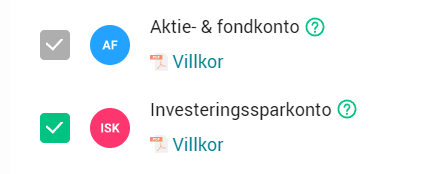Hey folx,
Let’s kickstart this pension saving/investment strategy Sweden edition by going over the 3 most common account types, how they work and why I think ISK is they way to go.
As mentioned, there are 3 common account types when investing in Sweden:
– Aktie- & fondkonto (AF)
– Kapitalförsäkring (KF)
– Investeringssparkonto (ISK)
They all function a little bit differently with regards to taxation and beneficiaries etc. Let’s go over them one by one.
Aktie- & fondkonto (AF)
This is a standard investment account, meaning you can trade funds, stock, bonds, exchange-traded funds (ETFs) and all other kinds of financial instruments, and as the account holder you’re the sole beneficiary of the account. This means that in the case of your death the content of the account will pass to your estate (🇸🇪 dödsbo).
Tax wise this is an account where your assets are only taxed at point of sale and at 30% of the profit in the case of a gain. Your gains and losses are then documented yearly when you do your taxes (deklaration) by including a so called K4 form. Most (if not all) online brokers can generate a complete K4 form for a small fee (worth it imho!). Do note that you will need to hold on to the 30% profit tax until it’s time to pay your taxes, meaning it’s not automatically deducted by your broker/bank.
It’s worth noting that AF accounts allow you to net your gains and your losses against their own kind. Meaning you can net a loss against a gain, thus reducing the total amount of tax you end up paying. However, this indicates that AF is an account more suitable for less passive strategies (more buying/selling). And since most (if not all) hobby investors would be much better off not meddling in their investment (at all) I won’t be recommending AF for passive investment strategies.
Investeringssparkonto (ISK)
This is a standard investment account, meaning you can trade funds, stock, bonds, exchange-traded funds (ETFs) and all other kinds of financial instruments, and as the account holder you’re the sole beneficiary of the account. This means that in the case of your death the content of the account will pass to your estate (🇸🇪 dödsbo).
This account was introduced in 2012 as an initiative to simplify investing for the “average Swede”. The main simplification revolves around taxation. The simplification consists of you not being taxed for actual income, gains and losses. Instead, a standard revenue is taxed. This means there’s no need to keep track of gains and losses or creating a K4 form. Instead, tax is deducted from your ISK account continuously through out the year.
Small note on the taxation %: the taxable amount is calculated as a 1/4 of the sum of:
– the value of your investments at the start of each quarter
– deposits to the account during the year
– the value of any transfers of securities to the account
The taxable amount is then multiplied with the government loan interest rate (statslåneräntan) as per 30th of Nov the year before + 1%. Do note that there’s a floor of 1.25% (the tax can never be lower than this).
Since the tax is continuously deducted from the account it creates virtually no overhead for you as an account holder when doing your taxes and makes it well suited for passive investment strategies.
Kapitalförsäkring (KF)
This is a standard investment account, meaning you can trade funds, stock, bonds, exchange-traded funds (ETFs) and all other kinds of financial instruments.
What sets it apart from AF and ISK is the way you can tweak beneficiaries of the account. Meaning you can for example have your kids added as the beneficiaries on the account, which would mean that the money will legally be theirs when they turn 18 (the age can be configured). This also means that in the case of death the value of your KF account will pass to any configured beneficiary of the account (rather than your estate as with AF and ISK). This is worth noting for “sambos” (partners living together) as sambos don’t have any legal claim on their sambo’s estate (🇸🇪 dödsbo).
Other than that KF is very similar to ISK, meaning a standard revenue is taxed and there’s no need to keep track of gains and losses.
Small note on the taxation %: the taxable amount is calculated as the sum of:
- the value of your investments Jan 1st
- deposits to the account during the year (Q1+Q2 deposits: 100% of the value, Q3+Q4 deposits: 50%)
The taxable amount is then multiplied with the government loan interest rate (statslåneräntan) as per 30th of Nov the year before + 1%. Do note that there’s a floor of 1.25% (the tax can never be lower than this). This amount is then taxed at 30%.
So as you can see there’s a slight difference in how the standard revenue tax is calculated for ISK and KF respectively.
Another major difference, compared to the other account types, is the fact that if you own stock in a company via a KF you do not have the right to vote at annual general meeting, but if you own the stock via a AF or ISK you do. This usually isn’t a game changer for most regular investors but it’s worth noting.
Conclusion
For passive, long-term (10+ years) investment strategies without the need to configure beneficiaries, ISK is the best choice. You can open one free of charge at any of the best online investment banks in Sweden: Lysa, Avanza or Nordnet.
Why am I not mentioning any of the “big banks” in Sweden? I’ll let you know in an upcoming post.


Hi, this is a fantastic summary of the investment account types that are available in Sweden!